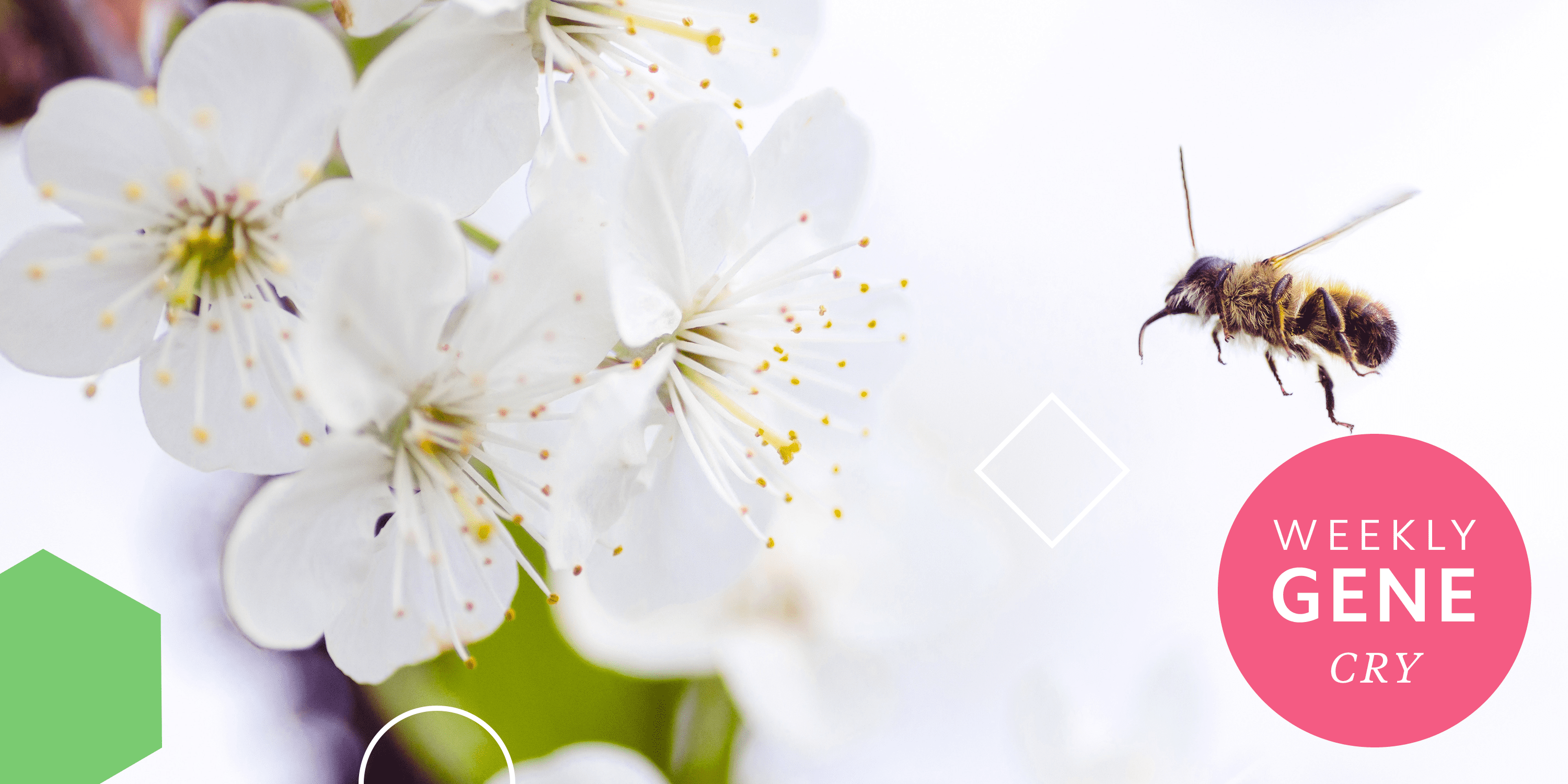A good CRY goes a long way for humans and bees

It’s like clockwork. Every day, at the same time, forager bees set out to collect nectar that will later be used to feed the hive. Their mission is not an aimless search, but rather a targeted foray guided by a mixture of sunlight and DNA. Rhythmic behavior can be found throughout the animal kingdom: bees forage, butterflies migrate, and humans sleep. Amazingly, one type of ancient gene is found in all of these animals, and it’s responsible for helping each of us keep track of time. They are known as the cryptochrome genes.
Cryptochrome genes (more commonly referred to as CRY genes) are ancient—meaning they’ve been around in some form or another for millions of years1. Early forms of life had to protect themselves from the damaging effects of light. We don’t often think about it, but light has the potential to break DNA, which can be a big problem for our cells. To combat this, cells evolved a new type of gene whose protein product could sense light and use it as a cue to start scanning the DNA for breakpoints that need repairing. Over time, this gene evolved into many different genes that have various light-related jobs. Some of those genes are now known as CRY genes1.
CRY genes make up a central part of the biological rhythm—also known as the circadian clock—in many different organisms. Humans have two different CRY genes (CRY1 and CRY2). Together, they help cells in our body progress through a 24-hour cycle. In a nutshell, our daily rhythm of waking up, eating, being active, and falling asleep follows a regular pattern. That pattern is influenced by many factors including light, food, temperature, and our genetics. Genes like the CLOCK and CRY genes help our bodies maintain this rhythm in the same way that gears in a clock help it tick away with regularity1,2.
The same is true for other organisms as well, including honey bees and butterflies1. Honey bees are an extremely social species (also known as eusocial) who participate in socially determined activities. One of these activities is when forager bees leave the hive in search of food. Researchers have found that bees can be trained to search for food at specific times and in specific intervals with a remarkable level of adaptivity3-5. While studying this behavior, researchers have also found that genes involved in maintaining a circadian rhythm—including a version of the Cry gene that’s similar to ours—are important timekeeping tools for bees. Studies suggest that circadian genes help align social behaviors across the hundreds of workers in a hive, some of which may be spread out over wide distances1,3-5.
Part of this social alignment involves the sun. To understand this, it helps to look at monarch butterflies. These insects participate in a seasonal migration from northern territories down towards Mexico each autumn1. This regular migration relies on a butterfly’s ability to sense sunlight intensities at different times of day. This is where the circadian clock is helpful. Once the change in daylight lines up appropriately with the circadian clock, butterflies can be cued to migrate1,6.

CRY vs Cry?
Did you notice a formatting change in our text? It was no accident, capitalization of gene names can tell you a lot about the gene. Here, the full capitalization of CRY indicates that it’s referring to a human gene. The other format, Cry, tells you it’s referring to a gene in one of multiple animal groups that includes insects.
In each of these animals, Cry proteins are important elements of their internal clock. It’s important to note that the CRY genes are not exactly the same in humans as they are in bees or butterflies, but they’re very similar1. These differences may impact how the gene is regulated and ultimately affect different species’ circadian rhythms differently.
We can see this within humans, too. Some people have small changes in their CRY genes that affect their sleep habits2,7. One such change happens in the CRY1 gene and is associated with a condition known as Familial Delayed Sleep Phase Syndrome, where a person tends to fall asleep later than the societal average (sometimes by hours)7. This is an example of a dramatic shift in sleep that can result from genetic changes, but there are also more subtle ones that we’ve reviewed here.
Ultimately, the CRY genes provide a great example of an ancient gene that’s been passed down for millions of years. These genes have evolved to serve the specific needs of animals (and plants). Whether in bees, butterflies, or humans, the CRY genes help maintain life’s many rhythms.
- Chaves, Inês, et al. “The Cryptochromes: Blue Light Photoreceptors in Plants and Animals.” Annual Review of Plant Biology, vol. 62, no. 1, Feb. 2011, pp. 335–364., doi:10.1146/annurev-arplant-042110-103759.
- Jagannath, Aarti et al. “The genetics of circadian rhythms, sleep and health” Human molecular genetics vol. 26,R2 (2017): R128-R138.
- Rubin, Elad B et al. “Molecular and phylogenetic analyses reveal mammalian-like clockwork in the honey bee (Apis mellifera) and shed new light on the molecular evolution of the circadian clock” Genome research vol. 16,11 (2006): 1352-65.
- Lehmann, Marina et al. “The early bee catches the flower – circadian rhythmicity influences learning performance in honey bees, Apis mellifera” Behavioral ecology and sociobiology vol. 65,2 (2010): 205-215.
- Bloch, Guy. “The Social Clock of the Honeybee.” Journal of Biological Rhythms, vol. 25, no. 5, 2010, pp. 307–317., doi:10.1177/0748730410380149.
- Reppert, S. M. “The Ancestral Circadian Clock of Monarch Butterflies: Role in Time-Compensated Sun Compass Orientation.” Cold Spring Harbor Symposia on Quantitative Biology, vol. 72, no. 1, 2007, pp. 113–118., doi:10.1101/sqb.2007.72.056.
- Patke, Alina et al. “Mutation of the Human Circadian Clock Gene CRY1 in Familial Delayed Sleep Phase Disorder” Cell vol. 169,2 (2017): 203-215.e13.
Categories